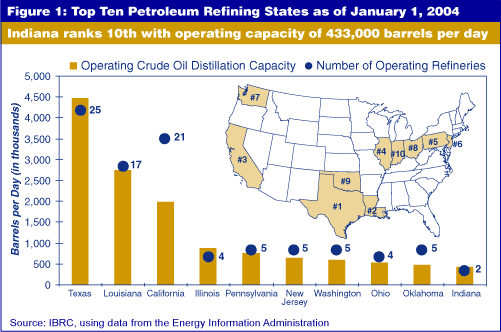Indiana: A Petroleum State?
Without knowing a thing about the Beverly Hillbillies, one might ask where this man named Jed might have moved to California from after striking “black gold, Texas tea.” One might make an educated guess and say Texas, Alaska or California. But could he have struck oil in the Hoosier state? According to the U.S. Department of Energy’s Energy Information Administration, Indiana produced 1,865,000 barrels of crude oil in 2003. That’s an average of 5,000 barrels a day. As of 2004, Indiana had 4,788 producing oil wells.(1)
Indiana had 19 million barrels of proved crude oil reserves as of 2003, ranking it 21st in the nation. Nevertheless, this accounted for less than 1 percent of the country’s crude oil reserves. Interestingly, to put this number in perspective, if Indiana citizens and businesses relied solely on gasoline produced from Indiana’s crude oil reserves,(2) at the current rate of consumption, the state would run out of gasoline in about 44 days.
Refining Oil in Indiana
We may not lead the nation in oil production, but what about refining oil? Well, it just so happens that as of January 2004, Indiana was one of the top 10 petroleum refining states, with an operating crude oil distillation capacity of 433,000 barrels a day (see Figure 1).

Indiana’s two refineries are at opposite ends of the state. The BP Products refinery in Whiting is one of the largest in the nation, with a daily distillation capacity of 410,000 barrels. Countrymark Cooperative in Mount Vernon, is significantly smaller, with a capacity of 23,000 barrels per day.
Petroleum and Gasoline Consumption
Indiana ranked 13th nationwide in both total petroleum consumption (17.7 million gallons per day) and gasoline consumption (8.7 million gallons per day) in 2001.
To see more lists and rankings of various energy data by state, check out www.eia.gov/state/rankings/?sid=US. To access Indiana’s energy profile, visit www.eia.gov/state/index.php?sid=IN.
American Community Survey Handbook
On January 10, the Census Bureau issued a press release entitled “National Mailing of New American Community Survey Marks Historic Shift for Census Bureau.” The shift centers on the timeliness of the data that this new endeavor will bring to communities, businesses, local and state governments, educators and students, nonprofit organizations and more. Last January, the Census Bureau began mailing the new survey to 250,000 addresses a month across the nation. Among the many publications available to the public on the Census website is the new American Community Survey—A Handbook for State and Local Officials. As people in your community begin to receive the survey, questions and issues may arise. The booklet is a reference for helping constituents deal with those questions and concerns.
Notes
- The term means a well that produces in paying quantities (that is, one for which proceeds from production exceed operating expenses).
- One barrel of crude oil yields 19.9 gallons of motor gasoline, as well as other petroleum products.
Frank Wilmot
State Data Center Coordinator, Indiana State Library
